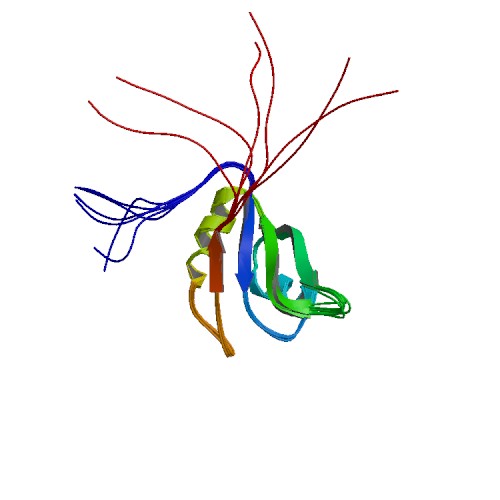EIF4H
| Eukaryotic translation initiation factor 4H | |||||||||||||
|---|---|---|---|---|---|---|---|---|---|---|---|---|---|
 PDB rendering based on 2dng. | |||||||||||||
| |||||||||||||
| Identifiers | |||||||||||||
| Symbols | EIF4H ; KIAA0038; WBSCR1; WSCR1 | ||||||||||||
| External IDs | Template:OMIM5 Template:MGI HomoloGene: 32536 | ||||||||||||
| |||||||||||||
| Orthologs | |||||||||||||
| Template:GNF Ortholog box | |||||||||||||
| Species | Human | Mouse | |||||||||||
| Entrez | n/a | n/a | |||||||||||
| Ensembl | n/a | n/a | |||||||||||
| UniProt | n/a | n/a | |||||||||||
| RefSeq (mRNA) | n/a | n/a | |||||||||||
| RefSeq (protein) | n/a | n/a | |||||||||||
| Location (UCSC) | n/a | n/a | |||||||||||
| PubMed search | n/a | n/a | |||||||||||
Eukaryotic translation initiation factor 4H, also known as EIF4H, is a human gene.[1]
This gene encodes one of the translation initiation factors, which functions to stimulate the initiation of protein synthesis at the level of mRNA utilization. This gene is deleted in Williams syndrome, a multisystem developmental disorder caused by the deletion of contiguous genes at 7q11.23. Alternative splicing of this gene generates 2 transcript variants.[1]
References
Further reading
- Nomura N, Miyajima N, Sazuka T; et al. (1995). "Prediction of the coding sequences of unidentified human genes. I. The coding sequences of 40 new genes (KIAA0001-KIAA0040) deduced by analysis of randomly sampled cDNA clones from human immature myeloid cell line KG-1". DNA Res. 1 (1): 27–35. PMID 7584026.
- Nomura N, Miyajima N, Sazuka T; et al. (1995). "Prediction of the coding sequences of unidentified human genes. I. The coding sequences of 40 new genes (KIAA0001-KIAA0040) deduced by analysis of randomly sampled cDNA clones from human immature myeloid cell line KG-1 (supplement)". DNA Res. 1 (1): 47–56. PMID 7584028.
- Osborne LR, Martindale D, Scherer SW; et al. (1997). "Identification of genes from a 500-kb region at 7q11.23 that is commonly deleted in Williams syndrome patients". Genomics. 36 (2): 328–36. doi:10.1006/geno.1996.0469. PMID 8812460.
- Richter-Cook NJ, Dever TE, Hensold JO, Merrick WC (1998). "Purification and characterization of a new eukaryotic protein translation factor. Eukaryotic initiation factor 4H". J. Biol. Chem. 273 (13): 7579–87. PMID 9516461.
- Richter NJ, Rogers GW, Hensold JO, Merrick WC (2000). "Further biochemical and kinetic characterization of human eukaryotic initiation factor 4H". J. Biol. Chem. 274 (50): 35415–24. PMID 10585411.
- Martindale DW, Wilson MD, Wang D; et al. (2000). "Comparative genomic sequence analysis of the Williams syndrome region (LIMK1-RFC2) of human chromosome 7q11.23". Mamm. Genome. 11 (10): 890–8. PMID 11003705.
- Rogers GW, Richter NJ, Lima WF, Merrick WC (2001). "Modulation of the helicase activity of eIF4A by eIF4B, eIF4H, and eIF4F". J. Biol. Chem. 276 (33): 30914–22. doi:10.1074/jbc.M100157200. PMID 11418588.
- Strausberg RL, Feingold EA, Grouse LH; et al. (2003). "Generation and initial analysis of more than 15,000 full-length human and mouse cDNA sequences". Proc. Natl. Acad. Sci. U.S.A. 99 (26): 16899–903. doi:10.1073/pnas.242603899. PMID 12477932.
- Gevaert K, Goethals M, Martens L; et al. (2004). "Exploring proteomes and analyzing protein processing by mass spectrometric identification of sorted N-terminal peptides". Nat. Biotechnol. 21 (5): 566–9. doi:10.1038/nbt810. PMID 12665801.
- Scherer SW, Cheung J, MacDonald JR; et al. (2003). "Human chromosome 7: DNA sequence and biology". Science. 300 (5620): 767–72. doi:10.1126/science.1083423. PMID 12690205.
- Hillier LW, Fulton RS, Fulton LA; et al. (2003). "The DNA sequence of human chromosome 7". Nature. 424 (6945): 157–64. doi:10.1038/nature01782. PMID 12853948.
- Doepker RC, Hsu WL, Saffran HA, Smiley JR (2004). "Herpes simplex virus virion host shutoff protein is stimulated by translation initiation factors eIF4B and eIF4H". J. Virol. 78 (9): 4684–99. PMID 15078951.
- Gerhard DS, Wagner L, Feingold EA; et al. (2004). "The status, quality, and expansion of the NIH full-length cDNA project: the Mammalian Gene Collection (MGC)". Genome Res. 14 (10B): 2121–7. doi:10.1101/gr.2596504. PMID 15489334.
- Rush J, Moritz A, Lee KA; et al. (2005). "Immunoaffinity profiling of tyrosine phosphorylation in cancer cells". Nat. Biotechnol. 23 (1): 94–101. doi:10.1038/nbt1046. PMID 15592455.
- Feng P, Everly DN, Read GS (2005). "mRNA decay during herpes simplex virus (HSV) infections: protein-protein interactions involving the HSV virion host shutoff protein and translation factors eIF4H and eIF4A". J. Virol. 79 (15): 9651–64. doi:10.1128/JVI.79.15.9651-9664.2005. PMID 16014927.
- Tao WA, Wollscheid B, O'Brien R; et al. (2005). "Quantitative phosphoproteome analysis using a dendrimer conjugation chemistry and tandem mass spectrometry". Nat. Methods. 2 (8): 591–8. doi:10.1038/nmeth776. PMID 16094384.
- Rual JF, Venkatesan K, Hao T; et al. (2005). "Towards a proteome-scale map of the human protein-protein interaction network". Nature. 437 (7062): 1173–8. doi:10.1038/nature04209. PMID 16189514.
| This protein-related article is a stub. You can help Wikipedia by expanding it. |